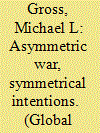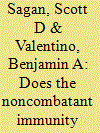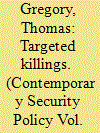| Srl | Item |
| 1 |
ID:
092120


|
|
|
|
|
| Publication |
2009.
|
| Summary/Abstract |
During asymmetric war, a state actor often faces charges of disproportionate harm while the weaker, nonstate side must defend itself against charges of terrorism. Because the state actor faces an adversary embedded among civilians, and the nonstate actor confronts an opponent whose military targets are often so well protected that only its nonmilitary targets are vulnerable, it is difficult for either side to fight without harming civilians. While humanitarian law tries to protect noncombatants to the greatest extent possible, too strict an interpretation of terrorism and proportionality may unduly restrict either side's ability to pursue political claims by force of arms. To successfully walk the line between protecting civilians during asymmetric war and allowing each side a 'fighting chance', it is necessary to take another look at the idea of intentionality and the definition of combatants. While intentional harm is the hallmark of terrorism, state armies also bring intentional harm if they expect to glean military benefits from causing collateral damage to civilians. A tighter understanding of intentionality can further protect innocent, noncombatant civilians. At the same time, however, the international community must recognise that not all civilians are noncombatants. Many civilians take a direct or indirect role in the fighting. As such, some civilians are vulnerable to lethal harm while others remain subject to nonlethal harm. Asymmetric war expands the range of permissible civilian targets that each side may attack without incurring charges of terrorism or disproportionate harm.
|
|
|
|
|
|
|
|
|
|
|
|
|
|
|
|
| 2 |
ID:
175081


|
|
|
| 3 |
ID:
153884


|
|
|
|
|
| Summary/Abstract |
The use of drones to kill suspected militants seems to provide a simple technical fix to a complex ethico-political problem: the need to discriminate between combatants and noncombatants. The technological ability of drones, combined with the rhetorical commitment to reducing civilian casualties, suggests that the principle of noncombatant immunity is firmly entrenched in debates about targeted killings. However, this article will argue that a peculiar effect of this enhanced technological capability has been to draw attention to the conceptual confusion that surrounds the distinction. Rather than assuming that it is a fixed feature of international law, I will argue that it should be viewed as a discursive formation that is contingent upon a precarious process of repetition and reiteration. Moreover, I will show how the laws designed to restrain the violence inflicted on civilian bodies have been invoked to render certain civilians vulnerable, constituting them as killable, their lives profoundly losable.
|
|
|
|
|
|
|
|
|
|
|
|
|
|
|
|